Following on from the Tung Chung Line, I’ll move onto the Airport Express line, with the full set of photos here. As previously described, the line shares track with the suburban service but skips a lot of the stations.
After the junction at Tung Chung it crosses a bridge to the island of Chek Lap Kok where the airport is located, then soon reaches the Airport station.
AsiaWorld-Expo forms the terminus of the line, being the next station after the airport, but still on the same island.
However, the main attraction of the Airport Express service is the provision of In Town Check In for passengers heading out to the airport: before boarding the train you can check in your baggage and receive your boarding pass from the airline counters at the railway station, so you don’t need to worry about your bags until the airport luggage reclaim at your final destination.
You pay for your journey by purchasing a single journey ticket, or using your Octopus card. The In Town Check In service is included in the cost of your train journey, as is free pickup and dropoff by minibus from various Hong Kong Island and Kowloon hotels.
If you use an Octopus card, it deducts the fare at the entry to the In Town Check In counters, and authorises your card so you can enter the platform downstairs. You can also just hop straight onto a train, but given the price premium charged for the Airport Express, you might as well just catch a cheaper bus to the airport. Here is the ticket barriers outside the check in desks at Kowloon station.
The check in counters are just like those the airport:
The stations look a lot like an airport as well: Hong Kong station.
Kowloon station.
When I travelled the train was almost empty: this photo shows the most crowded carriage I could find.
The carriage I was in had only one other passenger on board.
The trains are specially fitted out for the airport route, with luggage areas by the entry doors to hold big suitcases, and the seats have plenty of room underneath to place your hand luggage.
The network map looks pretty spiffy as well.
On thing I did notice was the amount of dwell time at stations. Hong Kong and Kowloon stations have extended stops due to the need to load the checked luggage into the baggage car: the car at the Hong Kong end of the EMU is fitted out as a luggage van, with five doors used to load the containerised baggage from the checking counters. It appears no luggage is carried on the airport -> Hong Kong leg of the journey.
At Tsing Yi the In Town Check In is not available, but the station stop still took ages – possibly we were waiting on a Tung Chung line metro train to pass us.
The final destination for most passengers is Airport station: for the departures terminal doors open on both sides: one side for Terminal 1 and the other for Terminal 2.
Luggage carts are lined up on both platforms, with ramps leading down into the terminals.
Finally – the cost.
Like most transport to airports, the fares are sky high (boom boom tish!). From Hong Kong station to the airport is $100 HKD, from Kowloon it is $90 HKD. For comparison the most expensive MTR single journey fare appears to be from Sheung Shui Station (on East Rail) to Tung Chung for $24 HKD, a distance about twice as long as that to the airport. Also for comparison, a Hong Kong to Tung Chung single journey fare is just $21 HKD, almost the same route as the Airport Express, but requiring a short but very cheap bus ride to actually reach the airport. There are a few more expensive fares on the MTR network, but they involve the border crossing stations of Lok Ma Chau and Lo Wu, at $50 HKD or so they fit into the same price gouging category.
None the less, with $7.8 HKD worth $1 USD, the airport fare worked out to be only about $14 AUD, or pretty good value compared to my usual train fare in Melbourne. That is even more impressive when you remember that the MTR receives no government subsidies towards their daily operations.

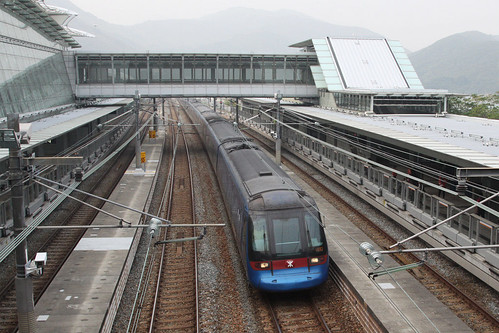
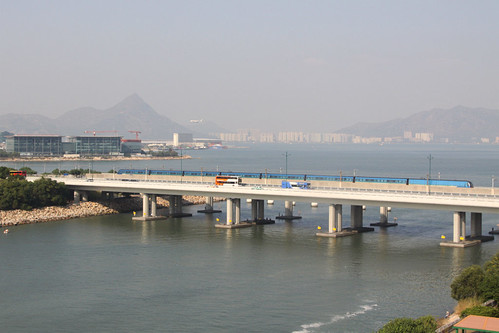
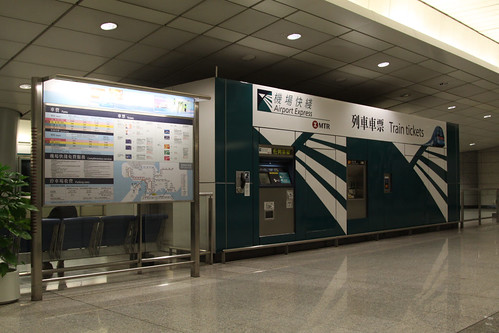
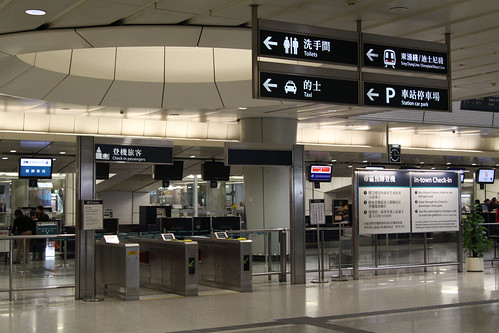

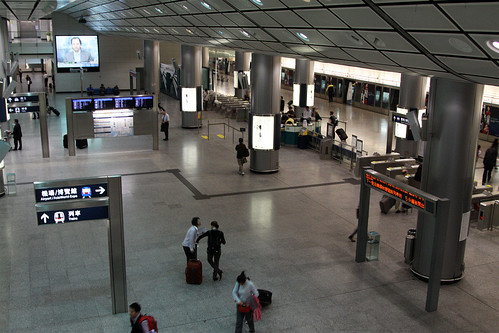
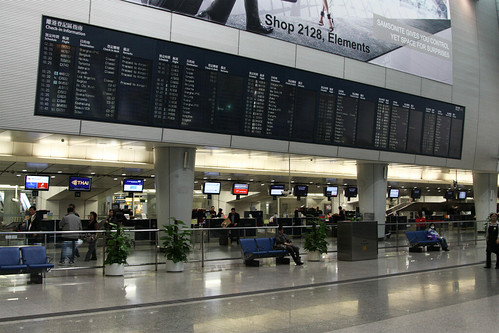
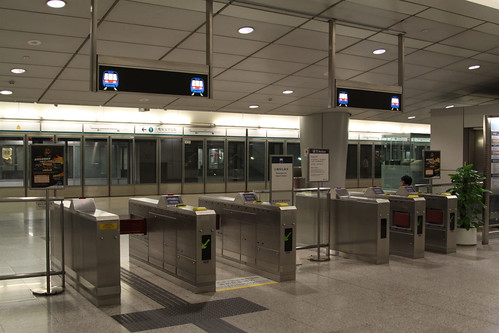

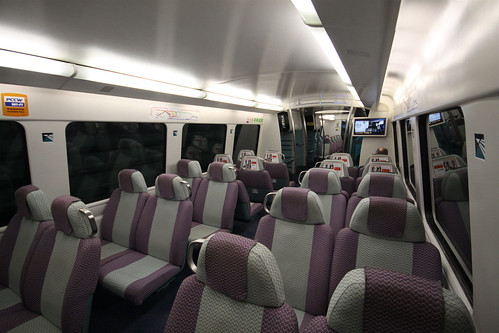
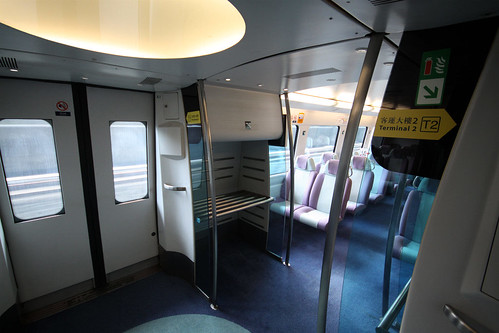
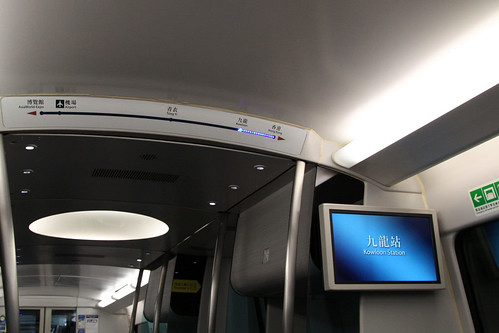
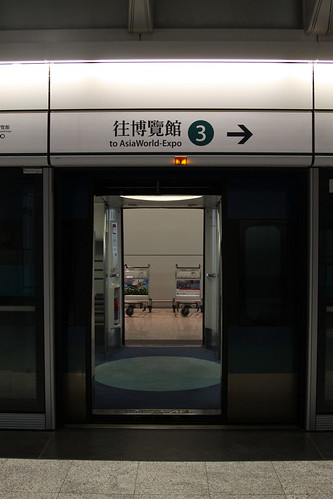
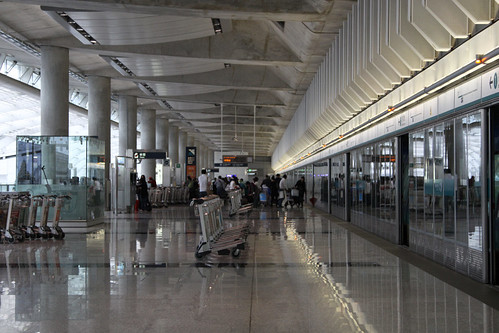
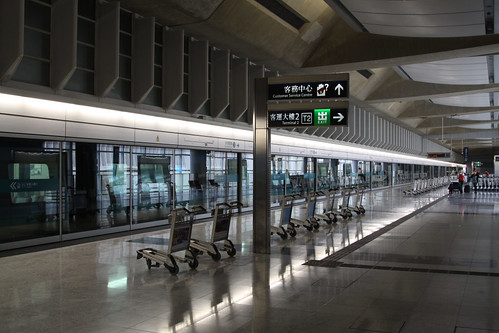
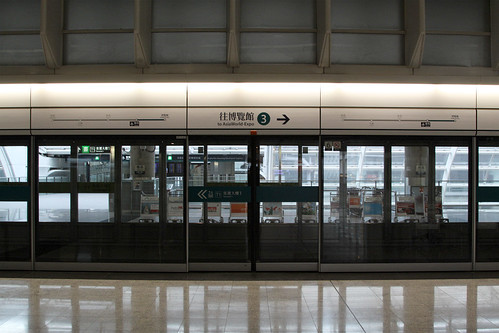

Pingback: Railfan’s guide to Hong Kong | Checkerboard Hill
Any photos of the interior of the luggage van of the Airport express train?
Sorry Herb, I don’t have any photos of the inside of the luggage van, or close up ones of the outside. Getting a good look at them is difficult – at each station the van sits off the public part of the platform, hidden behind a wall so that the loading and unloading of luggage containers can occur safely.
According to Wikipedia the van can hold 13 luggage containers:
https://en.wikipedia.org/wiki/MTR_Adtranz-CAF_EMU
I’m guessing they might use standard ULD (unit load device) containers, which are used throughout the aviation industry to carry air freight, as well as baggage:
http://en.wikipedia.org/wiki/Unit_load_device
Hi again!
I just found two links regarding the pictures of the luggage car:
The first one is a picture of the luggage being loaded by the unit load devices onto the train:
http://www.gakei.com/aex/hok04.jpg
The second picture is from Delhi Metro Airport Express, but since similar trains are used, the luggage van from the inside probably won’t look that different from that in the MTR:
http://www.hindustantimes.com/photos-news/Photos-India/newmetro/Article4-658978.aspx
Thanks for those photos Herb!
The reason for the similarities was that the MTR Corporation was a consultant on the New Dehli airport railway, and the trains were supplied by CAF – the same manufacturer who built the trains in Hong Kong:
http://delhimetrorail.info/AboutDelhiMetro.aspx
It looks like they can load the luggage van through multiple doors at once, and inside the train the containers don’t take up the entire van width, allowing for an emergency walkway between the cab and the passenger saloon.
It’s me again.
Found this actual picture on flickr of the MTR luggage car. It was photographed in an open house in Siu Ho Wan depot. It doesn’t look much different from the one in Delhi, but the MTR one seems to have its interiors incomplete thus exposing the frame of the train.
http://www.flickr.com/photos/train4life/3697601680/in/set-72157621083117714
Lucky find there Herb – with nothing in the caption saying it is MTR luggage carriage, it must have taken some digging to stumble upon it!
Are there trolleys for luggage to be pushed from airport going to Kowloon or HK island?
Arriving passengers can use the airport trolleys until they arrive at the entrance to the station, but there are poles preventing you from taking them on the train. I’m not sure of the situation once you arrive at Kowloon or Hong Kong stations.
As for the return leg, they are trolleys to use at the Kowloon or Hong Kong stations before you board the train, but you can’t take them down to platform level. Once you arrive at the airport, trolleys are waiting on the platform, which is a bit of a moot point, as you have probably dropped them off at the the In-Town Check-In counter.
Pingback: Transport market share to Hong Kong International Airport - Checkerboard Hill
Pingback: Seating onboard MTR trains - Checkerboard Hill
I love that at Airport station T1 side has the old PSDs and T2 side has the new PSDs
Nice pickup there!
T2 opened after the original terminal, so the different PSDs is presumably an artifact of this.
Pingback: Melbourne Airport rail and the diversification of SkyBus - Waking up in Geelong
Pingback: Baggage handing on the MTR Airport Express - Checkerboard Hill